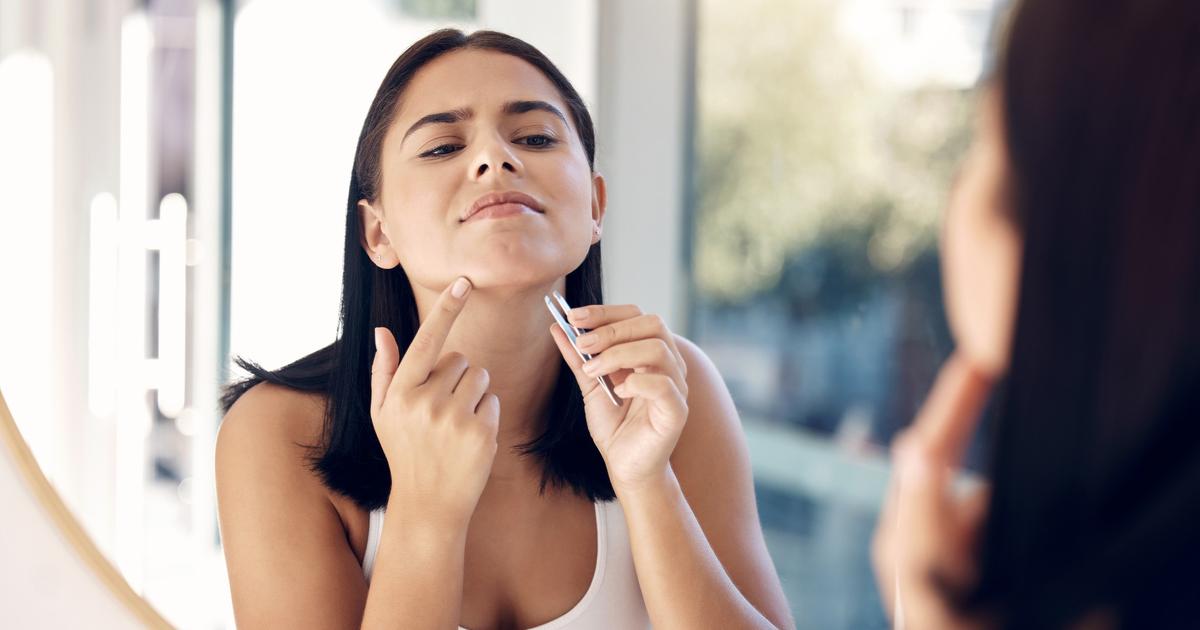It appears alone or in groups, and always seems to reappear in the same place.
“It’s completely normal,” reassures Doctor Gautier Doat, general practitioner and medical director of Avène: “It’s a physiological phenomenon.
We are all born with pilosebaceous follicles which form a layer of hair on the surface of the body.
We mainly have them on areas sensitive to hormones, such as the face and therefore the chin.
Hormonal influence
Indeed, if genetic and ethnic factors mainly influence the type and appearance of hairs located on the chin (giving them a light or dark, thin or thick appearance, etc.), it is hormones that play a crucial role in their frequency. appearance and their quantity.
“Women all have androgen hormones, the main male hormone, including testosterone.
This flows into the blood and therefore into the hair follicles of the facial hair.
They can appear more or less visible and numerous in certain women,” explains the specialist, who specifies that “sometimes, there may be one that is more prominent than the others.
You might think that it’s always the same one that grows back, but there are a multitude of small pilosebaceous glands there, so that’s not necessarily true.”
Also read Where does this single hair that grows tirelessly on the chin come from?
If this famous hair can appear at any period of our life, some will perhaps only discover it as they get older, while others who have been fighting against it for a long time can see it multiply over time. .
“At perimenopause or menopause, hair appears a little more prominently, because the female hormonal balance shifts in favor of androgens rather than estrogens.
The older we get, the more significant this imbalance is,” continues Doctor Doat, who insists again: “This event is completely normal.
And like hair, down hair can also turn white.”
Get rid of it... or not
Tweezers, depilatory cream, wax… If all these techniques to remove hair can be used, they will only be temporary and will not prevent it from growing back.
“However, it is not because we shave it that it will become thicker or multiply, it is a myth”, specifies the doctor.
The most effective method in the long term, according to him?
The laser, “because it destroys the bulb, which is the “factory” of the pilosebaceous follicle”.
However, as with all laser hair removal treatments, whatever the targeted area, the result will be less effective on light hair than on dark hair.
However, there is no question of persisting on it in vain as long as we do not feel the need.
“The most important thing is to ask yourself if it really bothers you.
Does it bother you when you look in the mirror?
Does this have an impact on your image and your quality of life?” asks Doctor Doat, who notes that these hairs “do not have the same impact on one woman or another.
People can experience it as a complex and feel a loss of self-esteem or self-confidence.
While others don’t care or live it very well, by removing hair or bleaching it.”
Hormonal disruption
Beyond the complex, the hair on the chin must be monitored in certain cases.
“It can be a sign of an underlying problem that influences hormonal concentration, such as hirsutism [
a medical term which designates a case of excessive hair growth in women, Editor's note
], polycystic ovary syndrome or a disorder of adrenal glands,” he warns.
While specifying that in this case, “hair on the chin should not be an isolated symptom but one among others, such as sudden weight gain, disruption of menstrual cycles, amenorrhea (absence of periods), or excessive hair that also affects other areas, such as the line between the navel and the pubis or the armpits.
A set of these symptoms will require an assessment and additional investigations.”
If you have the slightest doubt, Doctor Gautier Doat recommends consulting a doctor or dermatologist.
Pamela Anderson, Eva Longoria, Selena Gomez, Florence Pugh... 23 times celebrities caused a sensation without makeup in 2023
In images, in pictures
See the slideshow23 photos
See the slideshow23 photos

